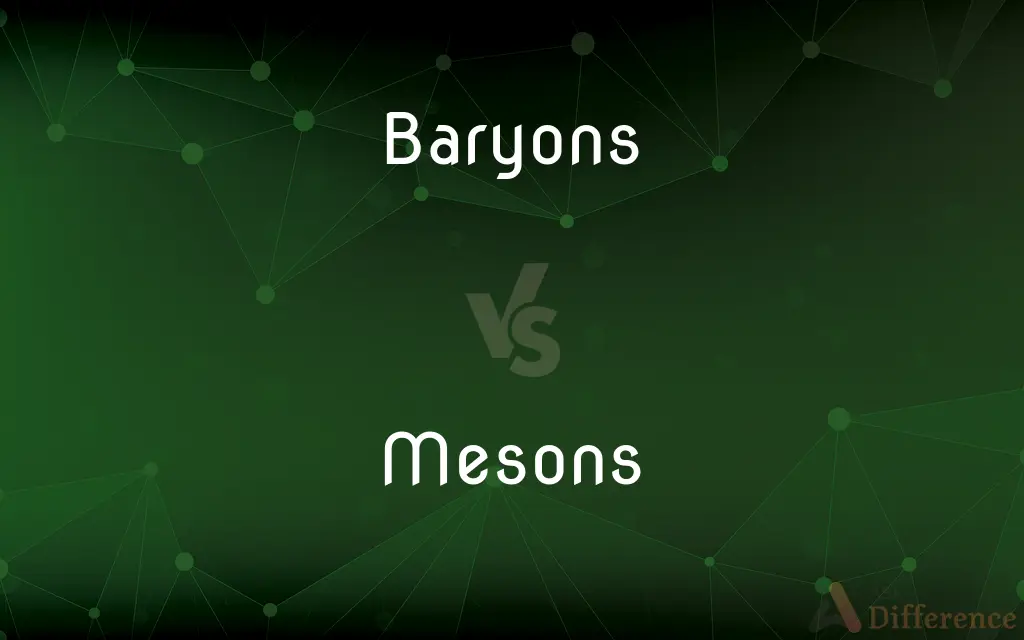Baryons vs. Mesons — What's the Difference?
Edited by Tayyaba Rehman — By Fiza Rafique — Published on December 12, 2023
Baryons are subatomic particles made up of three quarks, while Mesons consist of one quark and one antiquark.

Difference Between Baryons and Mesons
Table of Contents
ADVERTISEMENT
Key Differences
Baryons are subatomic particles that belong to the hadron family and are composed of three quarks. In contrast, Mesons are also hadrons, but they consist of a quark-antiquark pair.
Quark content sets Baryons apart from other subatomic entities. Protons and neutrons, which reside in atomic nuclei, are examples of baryons. On the other side, Mesons play a crucial role in mediating the strong nuclear force between baryons.
The stability of Baryons varies. While some, like protons, are stable and don't decay, others have very short lifetimes. On the contrary, Mesons are inherently unstable and decay rapidly, with lifetimes much shorter than baryons.
Baryons exhibit baryon number conservation, meaning processes or reactions that involve baryons always conserve the number of baryons. Mesons, being quark-antiquark pairs, have a baryon number of zero and do not affect the baryon number conservation in reactions.
In quantum chromodynamics, which studies strong interactions, Baryons and Mesons are understood in terms of color charge. Baryons always have a neutral or "white" color charge due to their three quark content, whereas mesons, with their quark-antiquark pairs, also maintain a neutral color balance.
ADVERTISEMENT
Comparison Chart
Composition
Three quarks
One quark and one antiquark
Examples
Protons, Neutrons
Pions, Kaons
Stability
Varies (Proton is stable)
Inherently unstable
Baryon Number
+1
0
Color Charge
Neutral (White)
Neutral (White)
Compare with Definitions
Baryons
Baryons are subatomic particles comprising three quarks.
The proton, found in atomic nuclei, is a baryon.
Mesons
Mesons are subatomic particles made of a quark and an antiquark.
Pions, involved in nuclear forces, are mesons.
Baryons
In terms of color charge, baryons are always neutral.
The combination of three quarks in baryons ensures a neutral color charge.
Mesons
Mesons belong to the hadron family due to their quark content.
Kaons, like pions, are a type of meson.
Baryons
Baryons belong to the hadron family due to their quark content.
Neutrons, just like protons, are baryons.
Mesons
Mesons maintain a neutral color charge due to their quark-antiquark composition.
Despite their quark content, mesons always exhibit a balanced color charge.
Baryons
Baryons observe the conservation of baryon number in reactions.
During a nuclear reaction, the total number of baryons remains constant.
Mesons
Mesons play a role in the strong nuclear force between baryons.
Mesons mediate the interactions between protons and neutrons in the nucleus.
Baryons
Baryons can either be stable or have varying degrees of instability.
While protons are stable, other baryons decay rapidly.
Mesons
Mesons are unstable and have short lifetimes.
Mesons decay rapidly, often into other particles.
Baryons
Any of a class of subatomic particles that are both hadrons and fermions, are composed of three quarks, participate in strong interactions, and are generally more massive than mesons and leptons. The class of baryons is divided into the nucleons and hyperons.
Mesons
Any of a class of subatomic particles that are both hadrons and bosons, are composed of a quark and an antiquark, participate in strong interactions, and have masses generally intermediate between those of leptons and baryons.
Baryons
Plural of baryon
Mesons
Plural of meson
Common Curiosities
Do both baryons and mesons belong to the same particle family?
Yes, both baryons and mesons are hadrons due to their quark composition.
Are all baryons stable?
No, while the proton is stable, many baryons have short lifetimes and decay.
Can you give a common example of a baryon?
A proton is a well-known baryon.
What's the primary distinction between baryons and mesons?
Baryons are composed of three quarks, while mesons consist of a quark and an antiquark.
How do mesons contribute to nuclear forces?
Mesons, especially pions, mediate the strong nuclear force between baryons.
How do baryons and mesons differ in terms of color charge?
Both baryons and mesons maintain a neutral color charge, but baryons achieve this with three quarks, while mesons use a quark-antiquark pair.
Do mesons have a long lifetime?
No, mesons are inherently unstable and decay rapidly.
Why are mesons important in nuclear physics?
Mesons mediate the strong nuclear force, which binds protons and neutrons in the nucleus.
What's another example of a meson besides the pion?
The kaon is another example of a meson.
Are neutrons considered baryons?
Yes, neutrons are baryons composed of three quarks.
How do mesons achieve a neutral color charge?
Mesons maintain a neutral color charge due to their quark-antiquark composition.
What are the quark components of mesons?
Mesons are made up of one quark and one antiquark.
What is the baryon number of mesons?
Mesons have a baryon number of zero.
Do reactions involving baryons conserve the baryon number?
Yes, baryon number conservation is observed in reactions involving baryons.
In which particle family do baryons and mesons belong?
Both baryons and mesons belong to the hadron family.
Share Your Discovery

Previous Comparison
Balance Sheet vs. Profit & Loss Account
Next Comparison
Equations vs. FunctionsAuthor Spotlight
Written by
Fiza RafiqueFiza Rafique is a skilled content writer at AskDifference.com, where she meticulously refines and enhances written pieces. Drawing from her vast editorial expertise, Fiza ensures clarity, accuracy, and precision in every article. Passionate about language, she continually seeks to elevate the quality of content for readers worldwide.
Edited by
Tayyaba RehmanTayyaba Rehman is a distinguished writer, currently serving as a primary contributor to askdifference.com. As a researcher in semantics and etymology, Tayyaba's passion for the complexity of languages and their distinctions has found a perfect home on the platform. Tayyaba delves into the intricacies of language, distinguishing between commonly confused words and phrases, thereby providing clarity for readers worldwide.











































